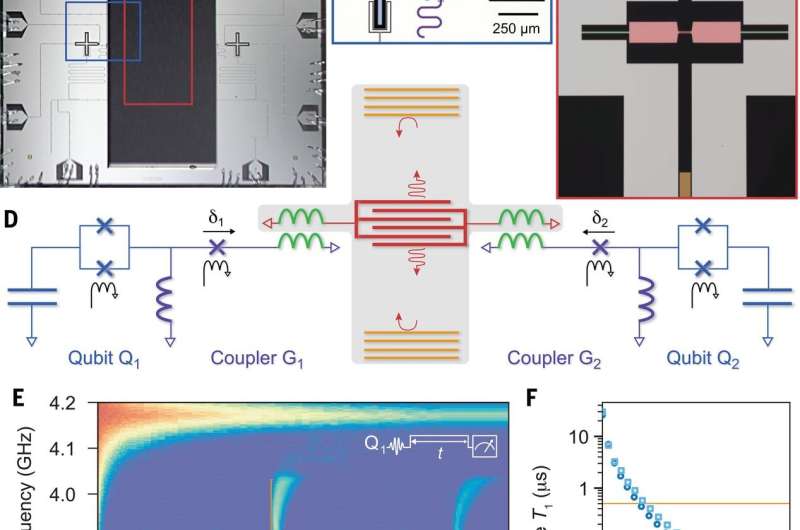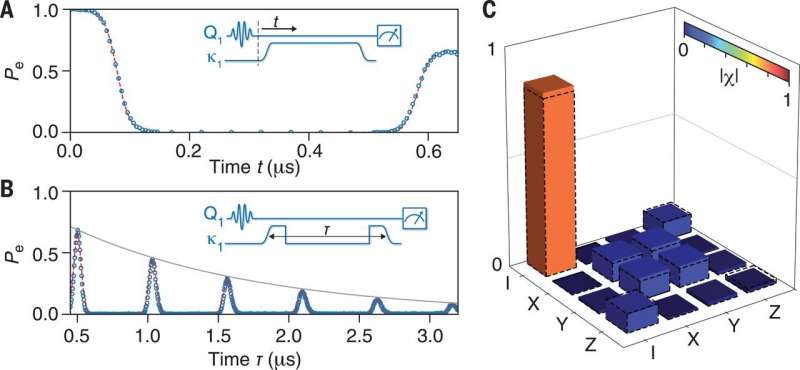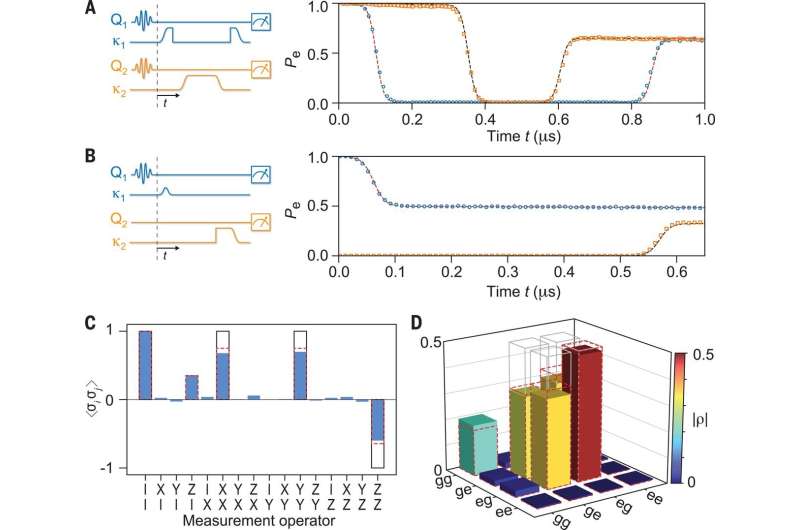Experimental device. (A to C) Micrograph of flip-chip assembled device (A), with two superconducting qubits (Q1 and Q2, blue), connected to two tunable couplers (G1 and G2, purple), fabricated on sapphire (B). These are connected via two overlaid inductors (green) to a SAW resonator (C), fabricated on lithium niobate. The SAW resonator comprises two Bragg mirrors (orange), spaced by 2 mm, defining a Fabry-Pérot acoustic cavity probed by an interdigitated transducer (red). The red and blue outlines in (A) represent the locations of (B) and (C), respectively. (D) Simplified circuit diagram, with the gray box indicating elements on the flipped lithium niobate chip. (E) Excited-state population Pe for qubit Q1, with coupler G1 set to maximum and G2 turned off. Q1 is prepared in |e⟩ using a π pulse, its frequency set to ωQ1 (vertical scale) for a time t (horizontal scale), before dispersive readout of its excited population Pe (28). Q1 relaxes owing to phonon emission via the IDT, and if its frequency is within the mirror stop band from 3.91 to 4.03 GHz, the emitted phonon is reflected and generates qubit excitation revivals at times τ (orange line) and 2τ. The inset shows the pulse sequence. (F) Measured qubit energy decay time T1 for ωQ,i/2π=3.95 GHz as a function of the coupler Josephson junction phase δi, showing the qubit emission can be considerably faster than the phonon transit time (orange line), for both Q1 (circles) and Q2 (squares). Credit: Science, doi: 10.1126/science.aaw8415
Quantum information platforms are based on qubits that talk to each other and photons (optical and microwave) are the carrier of choice—to date, to transfer quantum states between qubits. However, in some solid-state systems, acoustic vibrational properties of the material themselves known as phonons can be advantageous. In a recent study published on Science Advances, B. Bienfait and colleagues at the interdisciplinary departments of Molecular Engineering, Physics and Materials Science in the U.S. described the deterministic emission and capture of travelling (itinerant) phonons through an acoustic communication channel, to allow phonon-based coherent transfer of quantum states.
The scientists facilitated phonon transfer from one superconducting qubit (artificial atom) to another and observed the quantum entanglement (quantum state of each particle that cannot be described independently of the state of the other) of the two qubits in an acoustic channel during the study. Bienfait et al. provided a new route to couple hybrid quantum solid-state systems using surface acoustic waves as 'good vibrations' in quantum communication for future phononic applications.
Phonons, or more specifically, surface acoustic wave phonons, are proposed as a method to coherently couple distant solid-state quantum systems. For instance, individual phonons in a resonant structure can be controlled and detected using superconducting qubits (described as macroscopic, lithographically defined artificial atoms) to generate and measure complex, stationary phonon states coherently. In the present work, Bienfait et al. reported the deterministic emission and capture of traveling surface acoustic wave phonons to allow quantum entanglement of two superconducting qubits in an experimental setup.
They used a 2 mm-long acoustic quantum communication channel in the experiments, which allowed an approximately 500-nanosecond delay line, to demonstrate the emission and recapture of phonons. The scientists observed quantum state transfer between the two superconducting qubits with an efficiency of 67 percent and using partial transfer of a phonon, they generated an entangled Bell pair with a fidelity of 84 percent.
Electromagnetic waves have played a singular role as carriers of quantum information between distant quantum nodes for distributed quantum information processing. Previous quantum experiments have used microwave photons to demonstrate deterministic and probabilistic remote entanglement generation between superconducting qubits to reach entanglement fidelities ranging from 60 to 95 percent. For some solid-state quantum systems, such as electrostatically defined quantum dots or electronic spins, a quantum property of electrons (also known as spintronics), strong interactions with the host material have made acoustic vibrations (or phonons) a superior alternative compared to the photon candidates.
For example, surface-acoustic wave (SAW) phonons are proposed as a universal medium to couple remote quantum systems. These phonons can also efficiently convert between microwave and optical frequencies, linking microwave qubits to optical photons. As a result, many proposals have followed experiments to show the coherent emission and detection of traveling SAW phonons by a superconducting qubit, with sound taking on the role of light. Scientists have used traveling SAW phonons to transfer electrons between quantum dots to shuttle transport single electrons, coupled to nitrogen-vacancy centers and even drive silicon carbide spins. In previous work, researchers had also engineered standing-wave SAW phonons coherently coupled to superconducting qubits for the on-demand creation, detection and control of quantum acoustic states.
LEFT: Simplified circuit diagram, with the gray box indicating elements on the flipped lithium niobate chip. RIGHT: (A-B) Scanning electron micrographs detailing the IDT and Bragg mirrors. (C) Extracted qubit decay rate measured at maximum coupling. Decay is dominated by phonon emission from the IDT. Blue circles are extracted from an exponential decay fit; red dashed line is the predicted circuit model. Credit: Science, doi: 10.1126/science.aaw8415
Therefore, in the present work, Bienfait et al. used traveling (itinerant) SAW phonons to realize the transfer of quantum states between two superconducting qubits experimentally. In the acoustic part of the device, they used a SAW resonator with an effective Fabry-Pérot mirror spacing 2 mm, to generate a single-pass traveling phonon with a travel time of about 0.5 microseconds (µs). By design, coupling between the qubit and Fabry-Pérot mode in the system allowed the phonon to be completely injected into the acoustic channel. Bienfait et al. then coupled the resonator to two frequency-tunable superconducting "Xmon" qubits, Q1 and Q2 (where 'Xmon qubits' were first introduced by Barends et al), while controlling their coupling electronically using two other tunable couplers, G1 and G2. The scientists could switch each coupler from maximum coupling to off in a few nanoseconds to isolate the qubits.
The scientists engineered the tunable couplers, qubits and their respective control and readout lines on a sapphire substrate while constructing the SAW resonator on a separate lithium niobate substrate. For the SAW resonator, they used two acoustic mirrors with two Bragg mirrors (dielectric mirrors) on each side of the central acoustic emitter-receiver setup. For the acoustic emitter, they used an interdigital transducer (IDT) connected to a common electrical port.
The scientists applied an electric pulse to the IDT to form two symmetric SAW pulses, which traveled in opposite directions, reflecting off the mirrors to complete a round trip in 508 nanoseconds. Bienfait et al controlled the coupling of qubits to IDT, to facilitate time-domain shaped emission of traveling phonons in to the resonator. To characterize emission in the experiments, they excited the qubit first and monitored its excited-state population before taking the decaying state of excitation into account as a product of phonon emission.
(A) Calibrated control pulses (inset) ensure the release of a time-symmetric phonon and its efficient capture. Circles represent the measured excited-state population of Q1 when interrupting the sequence after a time t. (B) Measured excited-state population of Q1 while sweeping the delay between the emission and capture control pulses, evidencing a population geometrically decreasing with the number of transits (gray line). (C) Quantum process tomography at the maximum efficiency point of (B), with a process fidelity F1=0.83±0.002. (I) stands for the identity operator and X, Y, and Z for the Pauli operators. In (A) to (C), dashed lines indicate the results of a master equation simulation including a finite transfer efficiency and qubit imperfections. Credit: Science, doi: 10.1126/science.aaw8415
The scientists next experimentally showed the emission and capture of a traveling phonon employing a one-qubit, single-phonon "ping-pong" experiment using qubit Q1. In the experiment, they set coupler G1 to a maximum while turning the G2 coupler off to monitor the excited-state population (Pe) of Q1. They showed the emission took about 150 ns, after which Pe remained near zero during phonon transit in the experimental setup. After approximately 0.5 µs, Bienfait et al. were able to recapture the returning phonons with a capture efficiency of 67 percent.
During successive transits, the scientists observed a geometric decrease in the capture efficiency, which they credited to losses within the acoustic channel. They then conducted quantum process tomography of the one-qubit release-and-catch operation by reconstructing the process matrix with time. The quantum process tomography technique is the most appropriate and efficient scheme to analyze quantum systems when two-body interactions are not naturally available.
With Q1 initially prepared in |e⟩, a control signal on G1 releases and subsequently recaptures half a phonon to the resonator. Simultaneously, a 20-MHz detuning pulse of varying duration is applied to Q1 to change its phase by ∆ϕ. (A) Measured Q1 excited-state population when interrupting the sequence after a time t, with a phase difference ∆ϕ = 0 (squares) or π (circles). The inset shows the control sequence. (B) Q1 final state Pe(t=tf) for tf=0.65 μs as a function of the phase difference ∆ϕ between the half-photon and half-phonon. Circles are experimental points. Dashed lines are simulations based on an input-output theory model. Credit: Science, doi: 10.1126/science.aaw8415
Thereafter, the scientists demonstrated the interferometric nature of the one-qubit phonon emission and capture process. Since it is challenging to monitor the scheme for quantum entangling and mechanical superposition during quantum decoherence (quantum decay or loss of quantum behavior of particles), Bienfait et al prepared Q1 in a transition state to emit a half-phonon and captured it again with Q1 after one transit. The scientists defined capture as the time reversal of emission and predicted that the two half quanta will either interfere destructively to cause re-excitation of the qubit, or constructively for its total emission in the experimental setup.
As predicted, they showed that when the reflected half phonon interfered constructively with the emitted half phonon stored in Q1—the total energy transferred in to the SAW resonator, whereas destructive interference resulted in qubit re-excitation. The scientists used a simulation to include channel loss and qubit dephasing, to replicate experimental observations and credited any mismatch of the simulation to imperfections in the system. In this way, Bienfait et al used the experimental acoustic communication channel to transfer quantum states and generate remote entanglement between the two qubits.
(A) Qubit state swap via the acoustic channel, with control pulses shown on the left. (B) Acoustic entanglement. With Q1 initially in |e⟩, a control signal applied to G1 releases half a phonon to the channel, captured later by Q2. In (A) and (B), circles and squares are Q1 and Q2 excited-state populations measured simultaneously after a time t. (C and D) Expectation values of two-qubit Pauli operators (C) for the reconstructed Bell state density matrix (D) at t = 0.65 μs. In (C) and (D), solid lines indicate values expected for the ideal Bell state |Ψ⟩=(|eg⟩+|ge⟩)/2–√. In (A) to (D), dashed lines are simulation results including a finite transfer efficiency and qubit imperfections. Credit: Science, doi: 10.1126/science.aaw8415
The researchers also demonstrated quantum swap between the two qubits, Q1 and Q2, using the setup. This was possible since the scientists could sequentially store up to three traveling phonons in the SAW resonator. The process had a high fidelity rate, and the scientists credited any deviations to acoustic losses. As before, they used the acoustic channel to generate remote quantum entanglement between Q1 and Q2 to create a Bell state.
In this way, Bienfait et al. experimentally showed clear and compelling results for the controlled release and capture of travelling phonons into a confined Fabry-Pérot resonator, primarily limited by acoustic losses. They demonstrated that the emission and capture processes were not determined by the length of the resonator, so the same processes were applicable to a non-resonant acoustic device. In total, the scientists detailed processes to experimentally generate high fidelity entanglement between two qubits. These results will form a step forward to realize fundamental quantum communication protocols with phonons.
More information: A. Bienfait et al. Phonon-mediated quantum state transfer and remote qubit entanglement, Science (2019). DOI: 10.1126/science.aaw8415
Yu Chen et al. Qubit Architecture with High Coherence and Fast Tunable Coupling, Physical Review Letters (2014). DOI: 10.1103/PhysRevLett.113.220502
K. J. Satzinger et al. Quantum control of surface acoustic-wave phonons, Nature (2018). DOI: 10.1038/s41586-018-0719-5
Journal information: Science , Science Advances , Physical Review Letters , Nature
© 2019 Science X Network




























